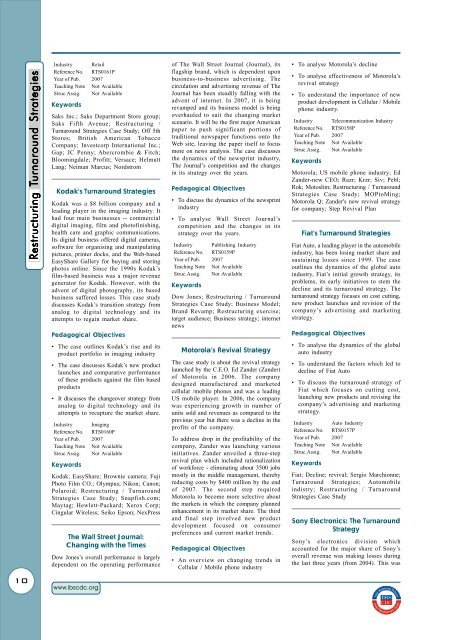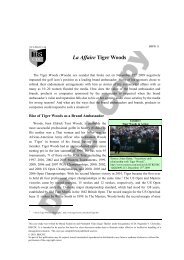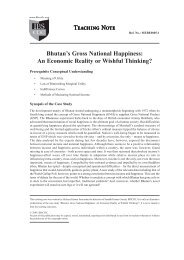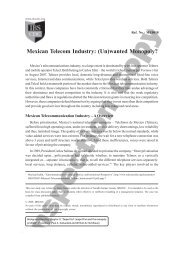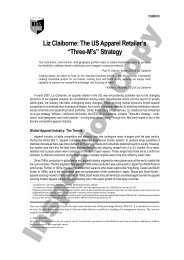List of Case Studies on Strategy - Case Catalogue IV
List of Case Studies on Strategy - Case Catalogue IV
List of Case Studies on Strategy - Case Catalogue IV
Create successful ePaper yourself
Turn your PDF publications into a flip-book with our unique Google optimized e-Paper software.
10<br />
Restructuring estructuring T TTurnaround<br />
T urnaround Strategies<br />
Strategies<br />
Industry Retail<br />
Reference No. RTS0161P<br />
Year <str<strong>on</strong>g>of</str<strong>on</strong>g> Pub. 2007<br />
Teaching Note Not Available<br />
Struc.Assig. Not Available<br />
Keywords<br />
Saks Inc.; Saks Department Store group;<br />
Saks Fifth Avenue; Restructuring /<br />
Turnaround Strategies <str<strong>on</strong>g>Case</str<strong>on</strong>g> Study; Off 5th<br />
Stores; British American Tobacco<br />
Company; Investcorp Internati<strong>on</strong>al Inc.;<br />
Gap; JC Penny; Abercrombie & Fitch;<br />
Bloomingdale; Pr<str<strong>on</strong>g>of</str<strong>on</strong>g>itt; Versace; Helmutt<br />
Lang; Neiman Marcus; Nordstrom<br />
Kodak's Turnaround Strategies<br />
Kodak was a $8 billi<strong>on</strong> company and a<br />
leading player in the imaging industry. It<br />
had four main businesses -- commercial<br />
digital imaging, film and phot<str<strong>on</strong>g>of</str<strong>on</strong>g>inishing,<br />
health care and graphic communicati<strong>on</strong>s.<br />
Its digital business <str<strong>on</strong>g>of</str<strong>on</strong>g>fered digital cameras,<br />
s<str<strong>on</strong>g>of</str<strong>on</strong>g>tware for organising and manipulating<br />
pictures, printer docks, and the Web-based<br />
EasyShare Gallery for buying and storing<br />
photos <strong>on</strong>line. Since the 1990s Kodak’s<br />
film-based business was a major revenue<br />
generator for Kodak. However, with the<br />
advent <str<strong>on</strong>g>of</str<strong>on</strong>g> digital photography, its based<br />
business suffered losses. This case study<br />
discusses Kodak’s transiti<strong>on</strong> strategy from<br />
analog to digital technology and its<br />
attempts to regain market share.<br />
Pedagogical Objectives<br />
• The case outlines Kodak’s rise and its<br />
product portfolio in imaging industry<br />
• The case discusses Kodak’s new product<br />
launches and comparative performance<br />
<str<strong>on</strong>g>of</str<strong>on</strong>g> these products against the film based<br />
products<br />
• It discusses the changeover strategy from<br />
analog to digital technology and its<br />
attempts to recapture the market share.<br />
Industry Imaging<br />
Reference No. RTS0160P<br />
Year <str<strong>on</strong>g>of</str<strong>on</strong>g> Pub. 2007<br />
Teaching Note Not Available<br />
Struc.Assig. Not Available<br />
Keywords<br />
Kodak; EasyShare; Brownie camera; Fuji<br />
Photo Film CO.; Olympus; Nik<strong>on</strong>; Can<strong>on</strong>;<br />
Polaroid; Restructuring / Turnaround<br />
Strategies <str<strong>on</strong>g>Case</str<strong>on</strong>g> Study; Snapfish.com;<br />
Maytag; Hewlett-Packard; Xerox Corp;<br />
Cingular Wireless; Seiko Eps<strong>on</strong>; NexPress<br />
The Wall Street Journal:<br />
Changing with the Times<br />
Dow J<strong>on</strong>es’s overall performance is largely<br />
dependent <strong>on</strong> the operating performance<br />
www.ibscdc.org<br />
<str<strong>on</strong>g>of</str<strong>on</strong>g> The Wall Street Journal (Journal), its<br />
flagship brand, which is dependent up<strong>on</strong><br />
business-to-business advertising. The<br />
circulati<strong>on</strong> and advertising revenue <str<strong>on</strong>g>of</str<strong>on</strong>g> The<br />
Journal has been steadily falling with the<br />
advent <str<strong>on</strong>g>of</str<strong>on</strong>g> internet. In 2007, it is being<br />
revamped and its business model is being<br />
overhauled to suit the changing market<br />
scenario. It will be the first major American<br />
paper to push significant porti<strong>on</strong>s <str<strong>on</strong>g>of</str<strong>on</strong>g><br />
traditi<strong>on</strong>al newspaper functi<strong>on</strong>s <strong>on</strong>to the<br />
Web site, leaving the paper itself to focus<br />
more <strong>on</strong> news analysis. The case discusses<br />
the dynamics <str<strong>on</strong>g>of</str<strong>on</strong>g> the newsprint industry,<br />
The Journal’s competiti<strong>on</strong> and the changes<br />
in its strategy over the years.<br />
Pedagogical Objectives<br />
• To discuss the dynamics <str<strong>on</strong>g>of</str<strong>on</strong>g> the newsprint<br />
industry<br />
• To analyse Wall Street Journal’s<br />
competiti<strong>on</strong> and the changes in its<br />
strategy over the years.<br />
Industry Publishing Industry<br />
Reference No. RTS0159P<br />
Year <str<strong>on</strong>g>of</str<strong>on</strong>g> Pub. 2007<br />
Teaching Note Not Available<br />
Struc.Assig. Not Available<br />
Keywords<br />
Dow J<strong>on</strong>es; Restructuring / Turnaround<br />
Strategies <str<strong>on</strong>g>Case</str<strong>on</strong>g> Study; Business Model;<br />
Brand Revamp; Restructuring exercise;<br />
target audience; Business strategy; internet<br />
news<br />
Motorola's Revival <strong>Strategy</strong><br />
The case study is about the revival strategy<br />
launched by the C.E.O. Ed Zander (Zander)<br />
<str<strong>on</strong>g>of</str<strong>on</strong>g> Motorola in 2006. The company<br />
designed manufactured and marketed<br />
cellular /mobile ph<strong>on</strong>es and was a leading<br />
US mobile player. In 2006, the company<br />
was experiencing growth in number <str<strong>on</strong>g>of</str<strong>on</strong>g><br />
units sold and revenues as compared to the<br />
previous year but there was a decline in the<br />
pr<str<strong>on</strong>g>of</str<strong>on</strong>g>its <str<strong>on</strong>g>of</str<strong>on</strong>g> the company.<br />
To address drop in the pr<str<strong>on</strong>g>of</str<strong>on</strong>g>itability <str<strong>on</strong>g>of</str<strong>on</strong>g> the<br />
company, Zander was launching various<br />
initiatives. Zander unveiled a three-step<br />
revival plan which included rati<strong>on</strong>alizati<strong>on</strong><br />
<str<strong>on</strong>g>of</str<strong>on</strong>g> workforce - eliminating about 3500 jobs<br />
mostly in the middle management, thereby<br />
reducing costs by $400 milli<strong>on</strong> by the end<br />
<str<strong>on</strong>g>of</str<strong>on</strong>g> 2007. The sec<strong>on</strong>d step required<br />
Motorola to become more selective about<br />
the markets in which the company planned<br />
enhancement in its market share. The third<br />
and final step involved new product<br />
development focused <strong>on</strong> c<strong>on</strong>sumer<br />
preferences and current market trends.<br />
Pedagogical Objectives<br />
• An overview <strong>on</strong> changing trends in<br />
Cellular / Mobile ph<strong>on</strong>e industry<br />
• To analyse Motorola’s decline<br />
• To analyse effectiveness <str<strong>on</strong>g>of</str<strong>on</strong>g> Motorola’s<br />
revival strategy<br />
• To understand the importance <str<strong>on</strong>g>of</str<strong>on</strong>g> new<br />
product development in Cellular / Mobile<br />
ph<strong>on</strong>e industry.<br />
Industry Telecommunicati<strong>on</strong> Industry<br />
Reference No. RTS0158P<br />
Year <str<strong>on</strong>g>of</str<strong>on</strong>g> Pub. 2007<br />
Teaching Note Not Available<br />
Struc.Assig. Not Available<br />
Keywords<br />
Motorola; US mobile ph<strong>on</strong>e industry; Ed<br />
Zander-new CEO; Razr; Krzr; Siv; Pebl;<br />
Rok; Motoslim; Restructuring / Turnaround<br />
Strategies <str<strong>on</strong>g>Case</str<strong>on</strong>g> Study; MOPtoMing;<br />
Motorola Q; Zander's new revival strategy<br />
for company; Step Revival Plan<br />
Fiat's Turnaround Strategies<br />
Fiat Auto, a leading player in the automobile<br />
industry, has been losing market share and<br />
sustaining losses since 1999. The case<br />
outlines the dynamics <str<strong>on</strong>g>of</str<strong>on</strong>g> the global auto<br />
industry, Fiat’s initial growth strategy, its<br />
problems, its early initiatives to stem the<br />
decline and its turnaround strategy. The<br />
turnaround strategy focuses <strong>on</strong> cost cutting,<br />
new product launches and revisi<strong>on</strong> <str<strong>on</strong>g>of</str<strong>on</strong>g> the<br />
company’s advertising and marketing<br />
strategy.<br />
Pedagogical Objectives<br />
• To analyse the dynamics <str<strong>on</strong>g>of</str<strong>on</strong>g> the global<br />
auto industry<br />
• To understand the factors which led to<br />
decline <str<strong>on</strong>g>of</str<strong>on</strong>g> Fiat Auto<br />
• To discuss the turnaround strategy <str<strong>on</strong>g>of</str<strong>on</strong>g><br />
Fiat which focuses <strong>on</strong> cutting cost,<br />
launching new products and revising the<br />
company’s advertising and marketing<br />
strategy.<br />
Industry Auto Industry<br />
Reference No. RTS0157P<br />
Year <str<strong>on</strong>g>of</str<strong>on</strong>g> Pub. 2007<br />
Teaching Note Not Available<br />
Struc.Assig. Not Available<br />
Keywords<br />
Fiat; Decline; revival; Sergio Marchi<strong>on</strong>ne;<br />
Turnaround Strategies; Automobile<br />
indistry; Restructuring / Turnaround<br />
Strategies <str<strong>on</strong>g>Case</str<strong>on</strong>g> Study<br />
S<strong>on</strong>y Electr<strong>on</strong>ics: The Turnaround<br />
<strong>Strategy</strong><br />
S<strong>on</strong>y’s electr<strong>on</strong>ics divisi<strong>on</strong> which<br />
accounted for the major share <str<strong>on</strong>g>of</str<strong>on</strong>g> S<strong>on</strong>y’s<br />
overall revenue was making losses during<br />
the last three years (from 2004). This was


